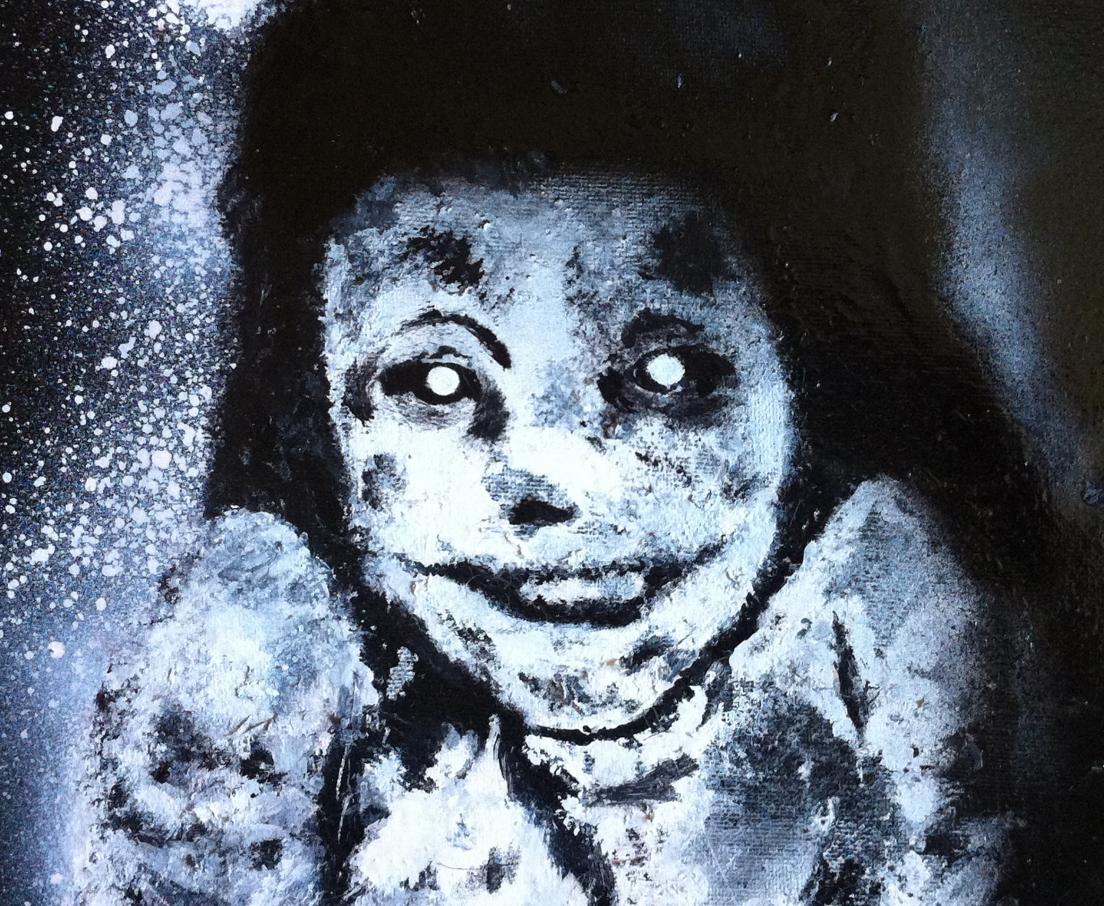Details
- 2013-07-07
- 0
- 82
- Painting
- Aerosol Paint
- Conceptual
Pricing
Price and availability not indicated

- DEATH TALKERS -
Description by Mister 13
Aerosol spray and kleenex on canvas. Most of the various forms of psychic phenomena associated with the Spiritualist movement are as old as man himself. Throughout the ages human beings have been aware of the existence of discarnate beings. In early days, when man lived close to nature, ancestor-worship became a form of religion; primitive man had no doubt that his ancestors had survived death and that they had powers to affect the living for good or ill. Therefore due reverence was shown to them in order to incur favour. The wise men of the tribe, who were possessed of psychic powers, the equivalent of modern mediums, would testify to the presence of the spirits and forms of communication were established with them. The Greeks consulted oracles and the Assyrians and Romans practised divination by augury to obtain guidance from the gods. Even today some cultures have their witch-doctors, who invoke the powers of the spirit for healing. It can be seen, therefore, that there is nothing new in the concept of a spiritual world inhabited by discarnate beings or in the use of psychic power to achieve spirit communication. The early Christian Church was founded on the basis of mediumship, Jesus of Nazareth being considered to have been an exceptionally gifted psychic and medium, as illustrated in the reports of his healing powers, inspired teachings, and so-called ‘miracles’. After the Crucifixion it is recorded that Jesus was seen and heard by Paul and others and it is clear that mediumship played an important part in the work of the Apostles in the spreading of this new religion and its presentation in Church services. The Bible in both the Old and New Testaments has many references to psychic abilities, inspirational speech, speaking in other languages, physical mediumship, healing and so on. However, the 4th century Council of Nicaea brought to an end the use of mediums and held that divine guidance, through the Holy Spirit, should be sought only from the priesthood: ‘false prophets’ were held to be servants of the devil, and sorcerers, heretics and mediums were all targets for persecution as a result of ‘witch-mania’. This accelerated in the Middle Ages, when religious sanction for this persecution was given in 1484 by a papal bull and by the publication of the Malleus Maleficarum or ‘Hammer of the Witches’. During this long period of persecution anyone suspected of using psychic gifts for whatever purpose was in danger of torture, trial and burning, and hundreds of thousands of mediums were put to death by organised ‘witch-hunters’. Modern Spiritualism is generally considered to date from the events which occurred at Hydesville (picture right), New York State, USA, on March 31st 1848, when two sisters, Margaretta and Catherine Fox (pictures below), established intelligent communication with a spirit entity which had been responsible for noisy rappings in the household. The publicity which this aroused and the numerous investigations carried out at the time allowed mediumship to come out into the open once more and many home circles sprang up for the purpose of further communication. In a short space of time many societies of Spiritualists were formed in America, based not merely upon the psychic phenomena produced but also upon the religious implications which lay behind the teachings received from spirit through the new revelation. Both the phenomena and the teachings attracted the attention of eminent scientists and intellectuals in America and (from 1852) Britain, to which Spiritualism was brought by Mrs Hayden, who was both persecuted and insulted by the press and the pulpit. In spite of this her mediumship was defended by many public figures, including Robert Owen, Socialist and one of the founders of the Co-operative Movement, who embraced Spiritualism after sittings with her, and many adherents were attracted to the cause. In 1853 the first Spiritualist Church was established in the British Isles by David Richmond at Keighley in Yorkshire (still in use today), and the first Spiritualist newspaper in Britain, The Yorkshire Spiritual Telegraph, was published in 1855, also at Keighley. By the 1870s there were numerous Spiritualist societies and churches throughout the country. In 1869 a Committee appointed by the Dialectical Society investigated Spiritualism and published the most favourable report on the movement up to that time by any investigating body. Two years later Sir William Crookes reported on Spiritualism to the Royal Society and published his findings in the Quarterly Journal of Science. The British National Association of Spiritualists (renamed in 1884 as the London Spiritualist Alliance and now known as the College of Psychic Science) was founded in London in 1873, followed by the Society for Psychical Research in 1882. Five years later the Two Worlds Spiritualist weekly newspaper was founded by Mrs Emma Hardinge Britten (picture left), through whose mediumship in 1871 Robert Owen had communicated the basis of the Seven Principles of Spiritualism, which were later to be adopted by the Spiritualists’ National Union as the basis of its religious philosophy. Physical mediumship has been known throughout history; every indigenous culture seems to have had physical mediums- sometimes called shamans or Wu in China. The Bible is full of reports of reports of physical mediumship. In 1901, US ethnologist Waldemar Bogoras traveled to Siberia to visit a shaman of the Tchouktchi tribe. Bogoras heard strange voices filling the room.The voices seemed to come from all corners and spoke English and Russian. It was the first known case in which direct spirit voices were caught in a recording.







